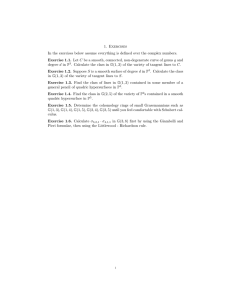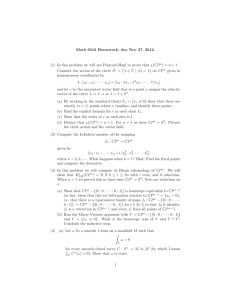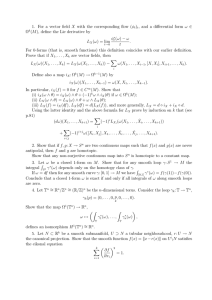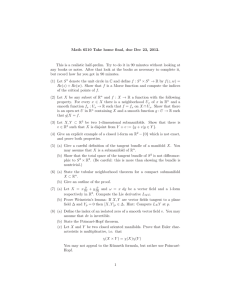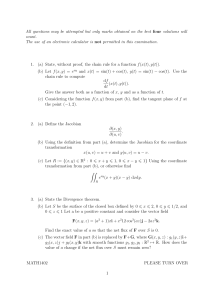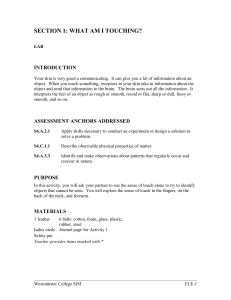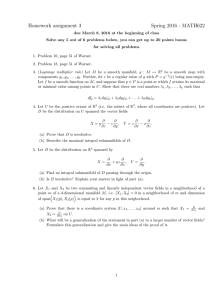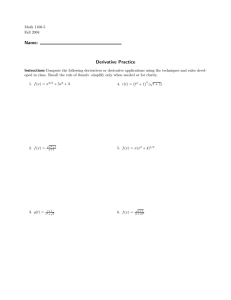m -surfaces in R n
advertisement
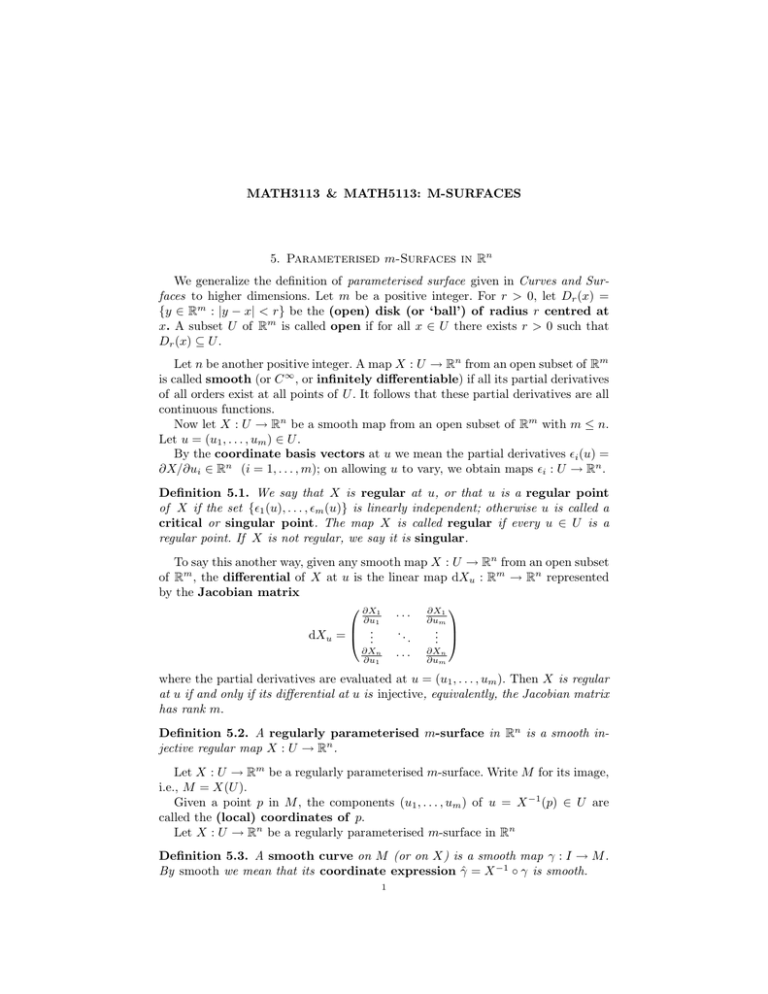
MATH3113 & MATH5113: M-SURFACES
5. Parameterised m-Surfaces in Rn
We generalize the definition of parameterised surface given in Curves and Surfaces to higher dimensions. Let m be a positive integer. For r > 0, let Dr (x) =
{y ∈ Rm : |y − x| < r} be the (open) disk (or ‘ball’) of radius r centred at
x. A subset U of Rm is called open if for all x ∈ U there exists r > 0 such that
Dr (x) ⊆ U .
Let n be another positive integer. A map X : U → Rn from an open subset of Rm
is called smooth (or C ∞ , or infinitely differentiable) if all its partial derivatives
of all orders exist at all points of U . It follows that these partial derivatives are all
continuous functions.
Now let X : U → Rn be a smooth map from an open subset of Rm with m ≤ n.
Let u = (u1 , . . . , um ) ∈ U .
By the coordinate basis vectors at u we mean the partial derivatives i (u) =
∂X/∂ui ∈ Rn (i = 1, . . . , m); on allowing u to vary, we obtain maps i : U → Rn .
Definition 5.1. We say that X is regular at u, or that u is a regular point
of X if the set {1 (u), . . . , m (u)} is linearly independent; otherwise u is called a
critical or singular point. The map X is called regular if every u ∈ U is a
regular point. If X is not regular, we say it is singular.
To say this another way, given any smooth map X : U → Rn from an open subset
of Rm , the differential of X at u is the linear map dXu : Rm → Rn represented
by the Jacobian matrix
∂X1
∂X1
· · · ∂u
∂u1
m
..
..
dXu = ...
.
.
∂Xn
∂Xn
· · · ∂um
∂u1
where the partial derivatives are evaluated at u = (u1 , . . . , um ). Then X is regular
at u if and only if its differential at u is injective, equivalently, the Jacobian matrix
has rank m.
Definition 5.2. A regularly parameterised m-surface in Rn is a smooth injective regular map X : U → Rn .
Let X : U → Rm be a regularly parameterised m-surface. Write M for its image,
i.e., M = X(U ).
Given a point p in M , the components (u1 , . . . , um ) of u = X −1 (p) ∈ U are
called the (local) coordinates of p.
Let X : U → Rn be a regularly parameterised m-surface in Rn
Definition 5.3. A smooth curve on M (or on X) is a smooth map γ : I → M .
By smooth we mean that its coordinate expression γ̂ = X −1 ◦ γ is smooth.
1
2
MATH3113 & MATH5113: M-SURFACES
Let p ∈ M . By a curve on M through p we mean a smooth map γ : I → M
with 0 ∈ I and γ(0) = p.
Definition 5.4. The tangent space to M (or to X) at p ∈ M is the subspace
Tp M = {v ∈ Rn : ∃ a smooth curve α : I → M through p with α0 (0) = v}.
Any v ∈ Tp M is called a tangent vector to M at p.
Proposition 5.5. (Basis for tangent space) For a regularly parameterised msurface in Rn , the coordinate basis vectors i (u) = ∂X/∂ui (i ∈ {1, . . . , m}) evaluated at u ∈ U give a basis for the tangent space Tp M at p = X(u).
Note that a parameterised 1-surface is the same as a simple regularly parameterised curve; in this case its tangent space is one-dimensional and spanned by the
unit tangent vector.
6. General definition of m-surfaces and level surfaces
As before, let m and n be arbitrary positive integers. We give a more abstract
definition of surface as suitable subsets of Rn .
Definition 6.1. A (smooth regular embedded) m-surface M in Rn is a subset of
Rn such that, for every p ∈ M , there is an open subset W of Rn containing p, such
that W ∩ M is a regularly parameterised surface, i.e. there exists an open subset U
of Rm and a smooth injective regular map X : U → M ∩ W .
We call such an X a (local) parameterisation of X(U ) ⊆ M (or of M ).
A common way of getting surfaces is from equations, i.e, as level sets.
Definition 6.2. Let W be an open subset of Rn and let f : W → Rk be a smooth
map. Suppose that k ≤ n. Then we say that p is a regular point if the Jacobian
matrix of f has rank k, otherwise it is called a critical point. A point c of f (W )
is called a critical value if c = f (p) for some critical point p ; otherwise it is called
a regular value.
Theorem 6.3. (Level sets as surfaces) Let f : W → Rk be a smooth map from
an open subset of Rn where k ≤ n. Suppose that c ∈ f (W ) is a regular value of f .
Then M = f −1 (c) = {x ∈ W : f (x) = c} is an m-surface, where m = n − k.
The set f −1 (c) = {x ∈ W : f (x) = c} is called the inverse image or level set
of c.
The proof uses the
Theorem 6.4. (Implicit Function Theorem) Let U be an open subset in Rk ×
Rm and f : U → Rk be a smooth function. Let a = (a1 , a2 ) ∈ U and write dfa =
[A, B], where A is the k×k matrix of derivatives with respect to the first k derivatives
and B is the k × m matrix of derivatives with respect to the last m derivatives.
Suppose that det A 6= 0, i.e. A is an invertible matrix. Then there exists an open
neighbourhood U1 of a1 in Rk , an open neighbourhood U2 of a2 in Rm , and a map
h : U2 → U1 , such that U1 × U2 ⊂ U and
{(x1 , x2 ) ∈ U1 × U2 ; f (x1 , x2 ) = f (a1 , a2 )} = {(h(y), y); y ∈ U2 }.
We now compare the approach in this chapter with that in the last.
MATH3113 & MATH5113: M-SURFACES
3
Lemma 6.5. (Local parameterisation = parameterised surface) Let M be
an m-surface in Rn . Then a smooth map X : U → Rn with image in M is a local
parameterisation of M if and only if it is injective and regular, i.e., if and only if
it is a regularly parameterised m-surface.
We can thus borrow a lot of concepts from those in in the previous section, for
example, given a point p in M , the components (u1 , . . . , um ) of u = X −1 (p) ∈ U
are called the (local) coordinates of p (with respect to the parameterisation X).
Lemma 6.6. Let f : M → N be a map from an m-surface in Rn to an k-surface
in Rl and let p ∈ M . Then the following three conditions are equivalent:
(i) There exists an open subset W 3 p in Rn and smooth map fˆ : W → Rl such
that fˆ|W ∩M = f|W ∩M .
(ii) There exist local parameterisations X : U → M (U open in Rm ) and Y :
V → N (V open in Rk ) with p ∈ X(U ) and f (p) ∈ Y (V ) such that the map
Y −1 ◦ f ◦ X is smooth on its domain;
(iii) For all local parameterisations X : U → M (U open in Rm ) and Y : V → N
(V open in Rk ) with p ∈ X(U ) and f (p) ∈ Y (V ), the map Y −1 ◦ f ◦ X is smooth
on its domain.
The proof uses again the Implicit Function Theorem and is omitted.
Definition 6.7. (Smooth maps) A map f : M → N which satisfies the equivalent
conditions in the above lemma is called smooth at the point p. It is called smooth,
if it is smooth at all points p ∈ M .
We define the tangent space Tp M at a point p of an m-surface M in Rn exactly
as in the last section. Then, given any local parameterisation X : U → Rn with
X(u) = p for some u ∈ U we obtain a basis {1 (u), . . . , m (u)} for Tp M as in
Proposition 5.5. If we take a different local parameterisation, in general we obtain
a different basis.
We now see how to measure how fast a function is varying as we move over a
surface.
Definition 6.8. (Directional derivative of a function wrt a vector) Let
f : M → R be a smooth function, p ∈ M , and v ∈ Tp M . The (directional)
derivative of f with respect to v is
v[f ] = (f ◦ α)0 (0)
where α : I → M is a smooth curve through p tangent to v.
Other notations in use: v[f ] = v(f ) = ∇v f .
Proposition 6.9. (Properties of directional derivative) Let p ∈ M , v, w ∈
Tp M , f, g smooth functions on M , and a, b ∈ R.
(i) (Well-definedness) v[f ] does not depend on the curve chosen. Thus the
directional derivative is well defined.
(ii) (Linearity) v[f ] is linear (over R) in both its arguments, i.e.,
(a) (av + bw)[f ] = a v[f ] + b w[f ], (b) v[af + b g] = a v[f ] + b v[g] .
(iii) (Formula in local coordinates) Let X : U → Rn be a local paramePm
terisation of M with p ∈ M . Write fˆ = f ◦ X. If v = i=1 vi i , then v[f ] =
Pm
ˆ
i=1 vi (∂ f /∂ui ), where the partial derivatives are evaluated at u = (u1 , . . . , um ) =
−1
X (p).
(iv) (Leibniz or product rule) v[f g] = f (p) v[g] + g(p) v[f ] .
4
MATH3113 & MATH5113: M-SURFACES
Proof. Generalize the proof for surfaces given in Curves and Surfaces.
Definition 6.10. (Vector field) A (smooth tangent) vector field on M is a
smooth mapping V : M → Rn such that for each p ∈ M , V (p) lies in Tp M . We
also denote V (p) by Vp .
We extend Definition 6.8 to derivatives with respect to vector fields:
Definition 6.11. (Directional derivative of a function wrt a vector field)
Given a vector field V and a smooth function f : M → R, the directional derivative of f with respect to V is the smooth function V [f ] : M → R defined by
V [f ](p) = Vp [f ].
We can also extend Definition 6.8 to derivatives of vector fields:
Definition 6.12. (Directional derivative of a vector field wrt a vector) Let
W be a vector field on M and v ∈ Tp M . Then the (directional) derivative of
W with respect to v is the vector
∇v W = (W ◦ α)0 (0)
where α : I → M is a curve through p ∈ M with α0 (0) = v.
Comparing this definition with Definition 6.8 we see
that if W = (W1 , . . . , Wn )
where Wi : M → R, then ∇v W = v[W1 ], . . . , v[Wn ] .
As in Curves and Surfaces we have the following properties:
Lemma 6.13. Let p ∈ M , v, w ∈ Tp M , V, W be vector fields on M , f a smooth
function on M , and a, b ∈ R. Then
(i) (Linearity) ∇v W is linear over R in both its arguments, i.e.,
(a) ∇av+bw W = a ∇v W + b ∇w W , (b) ∇v (aV + bW ) = a ∇v V + b ∇v W .
(ii) (Leibniz rule) ∇v (f W ) = v[f ]W (p) + f (p)∇v W.
(iii) (Compatibility with the metric) v[V · W ] = (∇v V ) · W (p) + V (p) ·
(∇v W ).
Definition 6.14. (Directional derivative of a vector field wrt a vector
field) Given two vector fields, U, V , the directional derivative of V with respect to U is the map ∇U V : M → Rn defined by (∇U V )(p) = ∇U (p) V (p ∈ M ).
∇U V : M → Rn , but it is not necessarily a tangent vector field..
Definition 6.15. The normal space to M (or X) at p ∈ M is the subspace
Np M = {v ∈ Rn : v · w = 0 for all w ∈ Tp M }.
Any v ∈ Np M is called a normal vector to M at p.
